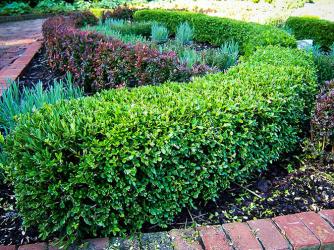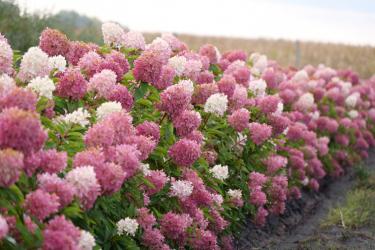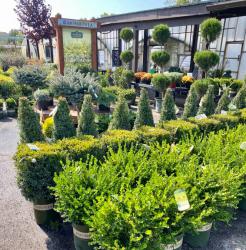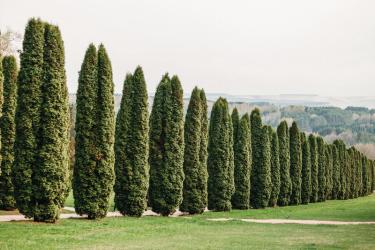For a tall hedge, choose Thuga Green Giant. It’s fast growing and tolerant of the St. Louis climate. For a hot, sunny location, choose juniper. Taylor juniper is tall and narrow, and it also tolerates direct sunlight well. —Meg Johnson, Timberwinds Nursery.
A medium size variety would be Techny Arborvitae. This is a personal favorite of my grandfather, father and myself because of the deep blue-green foliage. A large variety would be the very common Green Giant Arborvitae. It can get 12-16 feet wide and up to 60 feet tall. It also grows quite quickly. No matter how big Arborvitae get, they are all pretty easy to keep maintained to a desired size. —Anthony Frisella, Frisella Nursery.
Blooming Hedgerow With their long-blooming ostentatious blossoms, Panicle Hydrangeas produce spectacular hedges. Coming in many sizes, Panicle Hydrangeas fit into just about any landscape. Few plants can match the flamboyant display of “Zinfin Doll,” a 4-6-foot mid-size Panicle Hydrangea. The 8-foot tall “Limelight'' brings extraordinarily plump 12-inch chartreuse flowers that transform to bright white, then turn a rich deep pink. Use Panicle Hydrangeas to hide unsightly views, separate a property or line walkways. Reliable and low-maintenance, they grow fast, quickly forming an easy care dense, flowering hedge. —Ann Lapides, Sugar Creek Gardens.
Spruce, not Pine We do not typically recommend pines because they do not do well in heavy soils. Spruce varieties such as Norway or Surbian we would probably go more along the 12-16-foot range. For more immediacy, we may stagger them to fill in voids if space allows. Spruce in general get rather large. There are a couple more columnar spruce varieties called Wellspire or Cupressina that you could plant on 5-8-foot centers.—Anthony Frisella, Frisella Nursery.
General Hedgerow Maintenance Hedging plant material maintenance, plant health care and fertilization are critical for the success of a hedge. Monocultures are more difficult to achieve and maintain sustainability through the plantings as a whole. Proper pruning is critical depending on what you are hedging and ensuring that you will have the hedge for years to come. Based on the plant selection, reducing or thinning cuts need to be made rather than shearing the plant to help provide good air flow, prompt new growth and improve branching structure of the tree/shrub.—Justin Verbryck, Frisella Nursery.
Local Experts’ Favorites Boxwoods are Sherwood’s Forest go-to perfect hedge plant. Buxus comes in several varieties including Green Velvet, Winter Gem and Green Mountain Boxwood that grow to various heights and shapes. Boxwoods are easy to grow evergreens which like full to partial sun, moderate watering and acidic organic fertilizer. Boxwoods can be trimmed to natural rounded hedge as well as square or even topiary cone shaped. David Sherwood, Sherwood’s Forest Nursery.
What are all the benefits of growing a hedgerow?
Provides privacy from street traffic and neighbors
Creates a sound barrier to reduce noise
Acts as a windbreak to protect against harsh winds
Reduces snow in your yard
- Meg Johnson, Timberwinds Nursery.
When should you prune a hedgerow? Between Mother’s Day and Labor Day. Since Missouri has less than predictable winter, we like to advise pruning or shearing of evergreens between the times of Mother's Day and Labor Day. This will give ample cushion against early or late frost damaging newly trimmed plants. One of the best choices for evergreen hedging in St. Louis is Boxwood; they can handle our wet springs, dry summers and keep from being a deer buffet in sun or shade. For me the top choice is “Winter Gem.” It can reach a height and width of 4 feet and can be kept formal with shearing or left natural with minimal pruning to shape. —Craig Rapp, Greenscape Gardens.











